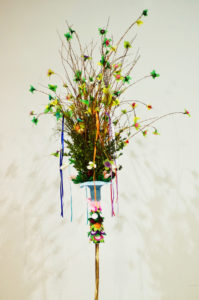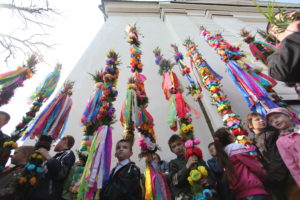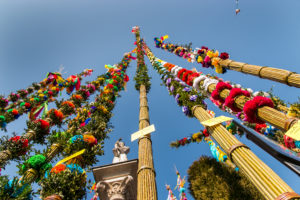
The first Review "Easter Palm Revue 2020" is behind us. This year, the grand prize was won by a photograph of a Greater Easter Palm submitted by the Pobiedziski Cultural Center.
The jury also awarded honorable mentions to:
Zosia Karpiel's 1. Photo of Easter Palm
2. Photo of Easter Palm from Podegrodzie, whose author is Piotr Droździk.
The prize was awarded to the photograph of the Easter Palm from Lipnica Murowana, submitted by the Municipal Cultural Center Lipnica Murowana.
W tym roku Niedziela Palmowa przebiegała w cieniu społecznej kwarantanny. Ciężko było sobie wyobrazić ten dzień bez tradycyjnych Palm Wielkanocnych. Dlatego Narodowy Instytut Kultury i Dziedzictwa Wsi zorganizował Przegląd „Rewia Palm Wielkanocnych”, którego celem było wyłonienie najpiękniejszej palmy uwiecznionej na fotografii. Ideą tego przedsięwzięcia było popularyzowanie oraz kultywowanie tradycji i zwyczajów wielkanocnych związanych z Niedzielą Palmową i Okresem Wielkanocy, pogłębianie wiedzy na temat symboliki i znaczenia palmy w obrzędowości ludowej oraz przekaz wartości i tradycji. Dyrektor Instytutu Karol Krajewski zachęcał do robienia palm, zwłaszcza w gronie rodzinnym, wykonania im zdjęcia i pokazania światu.
Zaproszenie to spotkało się z dużym odzewem. Nadesłano do nas ponad 200 prac fotograficznych z całej Polski. Wybór był niezwykle trudny, ponieważ wszystkie palmy były fantastyczne. Obrady Jury były dość emocjonujące, bowiem każdy z Nas miał swoje typy. Braliśmy pod uwagę nie tylko palmy, ale jakość zdjęć, która musiała być bardzo dobra – mówi Izabela Wolniak Pełnomocnik ds. Kultury NIKiDW oraz członek Jury.
Jestem wdzięczny za tak szeroki odzew i zaangażowanie w zorganizowane przez Nas przedsięwzięcie, szczególnie w tej trudnej sytuacji, w jakiej wszyscy się znaleźliśmy. Chciałbym szczególnie podziękować Kołom Gospodyń Wiejskich, wszystkim instytucjom, które dbają o kulturę i dziedzictwo wsi, oraz osobom prywatnym. Jestem pod ogromnym wrażeniem nakładu pracy jaki Państwo włożyli w przygotowanie prac. Wszystkie fotografie zostaną umieszczone w galerii Instytutu – mówi Dyrektor Instytutu Karol Krajewski.
Place 1 Greater Easter Palm.
This palm is characterized by being simple in structure, but varied in size, which  depended on where it was placed after dedication. Palms brought to small dwellings and houses were generally small, while those brought to mansions or estates were more magnificent. Wielkopolska palms are created from willow, wicker, hazel, currant or raspberry branches. The twigs tied in a sheaf, in two or one place, have a characteristic "broom" shape at the top. From this appearance comes the saying: "At Easter even the broomstick blooms". For nice green leaves, the more prudent cut the twigs on Ash Wednesday. After cutting them, they put them in water to develop buds. Those who have forgotten to do so or want a different decorative effect decorate the palm tree with green sprigs of periwinkle, sometimes replaced by boxwood. This is a distinctive and distinctive element for the Wielkopolska palm tree. Green decoration is also achieved by weaving into the willow vittles - sprigs of bilberry, yew, pitchfork or heather. Pretty branches with or without basil are decorated with colorful flowers and ribbons made of tissue paper, paper or colorful linen or wool.
depended on where it was placed after dedication. Palms brought to small dwellings and houses were generally small, while those brought to mansions or estates were more magnificent. Wielkopolska palms are created from willow, wicker, hazel, currant or raspberry branches. The twigs tied in a sheaf, in two or one place, have a characteristic "broom" shape at the top. From this appearance comes the saying: "At Easter even the broomstick blooms". For nice green leaves, the more prudent cut the twigs on Ash Wednesday. After cutting them, they put them in water to develop buds. Those who have forgotten to do so or want a different decorative effect decorate the palm tree with green sprigs of periwinkle, sometimes replaced by boxwood. This is a distinctive and distinctive element for the Wielkopolska palm tree. Green decoration is also achieved by weaving into the willow vittles - sprigs of bilberry, yew, pitchfork or heather. Pretty branches with or without basil are decorated with colorful flowers and ribbons made of tissue paper, paper or colorful linen or wool.

Honorable mention. Zosia Karpiel's Easter Palm.
The Easter Palm was made by Zosia Karpiel (age 5) from California (Pebble Beach), with the help of her parents and her grandmother Gosia, who, from Poland via FaceTime, with expert advice, assisted in the creation of the palm. Grandmother Gosia (a retired teacher) lives in the village of Polom Maly, Iwkowa commune, Malopolska province.
In the absence of traditional tissue paper, the palm was made from previously used gift wrapping paper (tissue paper), which Zosia has been collecting for years. After ironing the crumpled sheets, 45 flowers were handmade and upcycled, at Zosia's request, in the colors of the rainbow. Myrtle was replaced with rosemary from the garden. Rosemary and leaves from a California palm tree were used to crown the palm tree. The whole was decorated with ribbons and wicker discs, painted in Kurpie colors. The ribbons, like the paper, came from home collections.
Honorable mention. Easter palm from Podegrodzie.
Podegrodzie is the heart of the Sącz Lachs, where tradition and ritual is a permanent part of village life. The annual Easter Palm Contest brings together all the villagers around the church, and preparations take many months. Hazel, willow branches with basil, periwinkle, forest ivy, boxwood, reed grass and, above all, beautiful tissue paper flowers are the natural and traditional elements of each Podegrodzie palm.
A remarkable factual aid to the construction of traditional palms are the photographs of Wojciech Migacz, the first rural photographer of the Sącz village 100 years ago. His collection of photographs and negatives is an excellent documentation of the culture of the Sącz village. Many elements of this culture, including the customs and rituals of Palm Sunday, as well as folk costume or residential and farm buildings, are captured in his photographs.

MRiRW Award. Easter Palm from Lipnica Murowana.
The history of the competition for the most beautiful Easter Palm in Lipnica Murowana is 61 years old. Traditional Lipnica palms are made only from natural raw materials. The stem of the palm tree is wicker, which is also used to tie the carefully arranged rods. The palm is decorated with colorful tissue paper flowers, bases and evergreens, and a bundle of pond grass at the top. A traditional palm tree must fit in the hands of the performer and by the power of human hands must be erected. To meet this requirement, tall palms are reinforced in the middle with a wooden pole. It is customary for the youngest at home to learn palm making from their fathers and grandfathers, who pass on the knowledge and skills to their children and grandchildren. On Palm Sunday, low and medium palms surround the column of St. Simon of Lipnica standing in the central part of the market square, while the tallest ones (even exceeding 30 meters) are attached to the linden trees growing around the Lipnica market square. The tallest palm (37 meters and 78 centimeters) in the history of the competition, was made in 2019. - 21-year-old resident of Lipnica Górna (Lipnica Murowana municipality) - Andrzej Goryl.
Photo. archives of NIKiDW (photo submitted for the competition)
